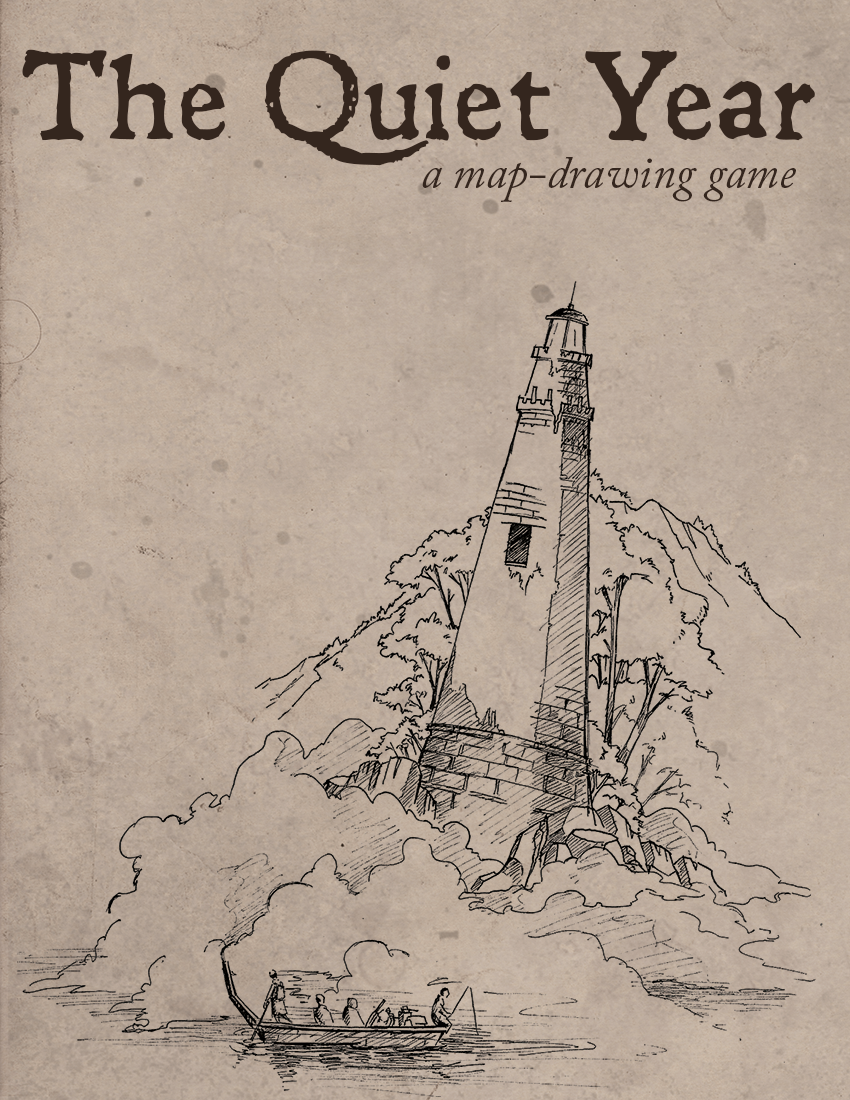The Quiet Year is a beautiful little game. It is so simple in its premise, yet it executes on its affective purpose so effectively and efficiently, it is really inspiring (so inspiring, in fact, that the TTRPG that I designed for this class, At the Edge of Everything, draws heavy inspiration from it, both in affect and in presentation).
In The Quiet Year, you construct the history of a town as it survives and eventually dies in an unknowable postapocalypse. You play not as specific characters from within this town, but as social forces, ebbing and flowing through the settlement, pushing on the status quo and pulling on rising conflict and tension. You express these changes and shifts not through speaking, but primarily through drawing – as a group, you and your fellow players draw a map of the town, adding new landmarks as the townsfolk construct new projects, and marking new conflicts and dangers that arise from the lands around your settlement.
In fact, this game very explicitly limits the players’ speech: it asks that only the player whose turn it is be the only person to speak, expect in special circumstances, where speech is even more limited – discussions for instance, where each player gets to say exactly one thing before their part in the conversation is over. It also very expressly limits what can get done in a given day – you can only really do two things each day: respond to the prompt on the card, and perform one other action. Frequently while playing this game, I felt like there was much to do and not enough time, or that there was something that we desperately needed to discuss before it was too late, but other things needed to get done, so a conversation might not happen until it is too late.
I found this limiting aspect of The Quiet Year to be quite powerful. It carries with it a very strong affective sense of too much to do, too little time. It very deftly encapsulated the challenging social dynamics of town-scale group interaction – no decisions were ever unanimously made, at no point could all voices be heard, often things would happen that I would staunchly disagree with, but I had to let happen because it was entirely out of my hands. The game anticipates these tensions, and introduces mechanics to make dissent known – it adds “Contempt Tokens,” which take the form of little skulls in the official version of the game. Whenever a player feels like some action was taken that they disagree with and were not consulted on or their opinion was not honored, they may take one or more of these skull tokens and place them in front of them to represent that player’s growing contempt. While these tokens don’t have any other mechanical functionality in terms of the gameplay, they are a very powerful affective device. Looking over at another player and seeing a bunch of tiny skulls staring back from in front of them on the table is a powerful reminder of the impact of your actions. Making a big decision and watching your peers reach over to grab a handful of tokens makes you instantly and deeply question your choices, and effects real change in player’s behavior as a whole.
Even the way the rulebook is constructed plays into The Quiet Year’s very strong affect. It has the facilitator read some of the initial rules aloud, but most of the rules are read communally, by passing the rulebook around and reading one page each, almost like a collective contract or constitution that each player agrees to. It has a powerful impact of engaging everyone in the rules of the game, but also binds the players together as a collective from before the game even starts.
The Quiet Year is a quiet, contemplative, often sad game that, through some key affective components, effects a really strong sense of community in all of its aspects: collaborative, contemptful, uplifting, and unable to ever share the full story. It is limiting in all of the right spaces, and offers key outlets where they are needed, and in doing so, creates a very cohesive and unique experience of abstraction beyond the individual and into the collective mind of a large community.
